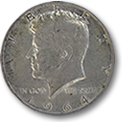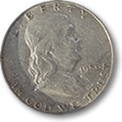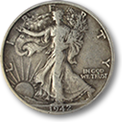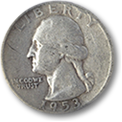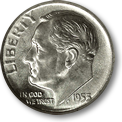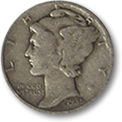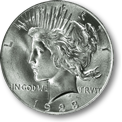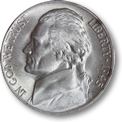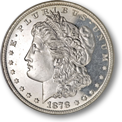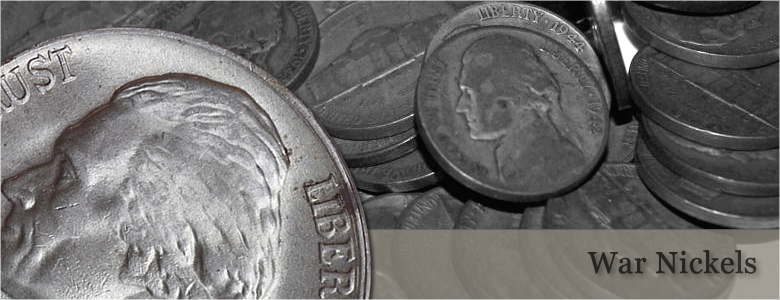
War Nickels History
War Nickels tell an important history of America during the great World War II efforts. This was a time when global communities were working together for a unified effort. Shared hardship was common, and for a war this big-- the metal, nickel, was in great demand.For the US Mint, this became a problem. For the first time in history, a nickel was minted with .350 or 35 percent silver metal content. Beginning in 1942 Jefferson Nickels were the first and only silver nickels in history. They are easily identified by the date, and by the large Mint mark that is placed over the dome of Monticello on its reverse. The regular nickel and copper-nickel coins do not have this.
The first of the Jefferson Nickels were minted in 1938. As was the tradition of the time, they were meant to commemorate and honor the presidency and accomplishments of Thomas Jefferson, third president from 1801-1809. His accomplishments were significant and a great desire to commemorate this was present in the American public. From the drafting of the Declaration of Independence in 1776, to the securing of the Louisiana Purchase, he also commissioned the Lewis and Clark expeditions that led to the unfortunate losses of the Indian Wars and the subsequent settlement of the West. This led to the development of the powerful new transportation option, the railways that still cross the continent today.
As was the tradition of the times, the US Mint Department hosted a national contest to flush the best design options from the prominent artists and sculptors working in the nation during that day. One thousand dollars was the big prize. It was won by Felix Schlag whose coin design depicted Jefferson's bust from a model made in 1789 by French Sculptor Jean-Antoin Houdon. A major artist of that era, history shows us that a number of presidential coin images were taken from his original bust sculpting work. Photographs were not as common and high quality images were needed to reflect precise likenesses of these great men onto the new American coinage.
The reverse of the coin depicts Jefferson's home at Monticello, Virginia. This was the image from 1938 through 2003, when the reverse received new designs in order to commemorate bicentennials of the Louisiana Purchase and the Lewis and Clark expedition. These are named the "Westward Journey" nickel series and were minted from 2004-2005. In 2006, the design for the reverse was returned to the Monticello series designs, while a new design of Jefferson facing forward was placed on the obverse.
Before the nickel was brought into currency, five-cent pieces were tiny silver coins called half-dimes. Contrary to the metal needs of World War II, during and after the American Civil War, it was silver that was in high demand. The copper-nickel alloy developed during the design and introduction of the original "Indian Head" and "Flying Eagle" nickel are still found today. The extreme hardness of this alloy caused many problems for the coinage stamping equipment. The die stamp often sustained damage; a problem solved by technology, and today has been completely resolved.
American currency has long kept coinage values within its metal content. The nickel held its value at one cent per gram, even when 35 percent silver was used to create the nickels during World War II. This five cent coin was designed to weigh five metric grams beginning in 1866, shortly before the July 28th Act of 1866 which declared the metric system legal for use in the United States.
The term "nickel" used to describe a coin actually began with the "Indian Head" coin, as this was a one-cent piece released in 1859 and circulated until 1969, the first that was made from a copper-nickel alloy. During the Civil War, they were interchangeably called "nickels," or "nicks." In 1865 a three-cent nickel came into the currency. To the folks on the street, these were the "new nickels." In 1866, the "Shield Nickel" came into the currency released under a brand new technology market that caused the spotlight that forever changed the way Americans associated the coins and nickel alloy with a particular denomination of value. It was due to the arrival of the public phone in 1888. Local public phone booth calls cost a nickel across the United States. In 1950 this charge was raised to a dime, except in some places such as New Orleans and in most of the largely rural areas. These phone booths only charged a nickel until the mid 1970's.
The phrase "it's your nickel" became popular during that era, for this reason. The term referred to the right of the person spending the nickel for the call, to be the one who got to speak first and most often. This cost of a single nickel was also true for the transportation systems for a one way ride for one person, and so the value became inherent in our speech as points of value reference. Later, national economy shifted, and for many decades, the phone call and bus ride could be had for a dime, giving rise to popular song phrases such as "brother can you spare a dime".
The circulation run of the War Nickels, the most rare of the nickel coins delivered, began in 1942 and closed in 1945. They were minted in Denver, San Francisco and Philadelphia. Most collection series will include one coin from each of those Mint Departments. The alloy combination includes 75 percent copper and 25 percent nickel. They have radical edges, and are 1.95 mm thick. The "war time" nickels were 35 percent silver and 56 percent copper with a small nine percent of manganese content. From a currency standard it represents five hundredths of one US dollar.
It was in 1866 the first five-cent "Shield Nickel" was introduced. It was designed by James B. Longacre. They were in circulation from 1866 through 1883. The earliest design hosts sun rays passing through the number five, while also passing through the spaces between the stars. The fine design detail failed to consider the hard alloy of nickel to be used. This oversight was a costly mistake causing damage, or presenting too-fine a line for many die, causing the stamps to give obscured images when stamped.
This unique error also became an advantage to its coin value for collectors, as the low number of predictable stamp variables has generated its own following of specialty series collectors. There are overdate errors, die cracks, doubled date errors and other kinds of die punch and over stamp mistakes.
The "war time" nickels that feature a large D as its Mint mark have the largest "D" the Denver mint ever stamped onto any US coin. It was placed directly over the Dome of Monticello facade on its reverse. A Mint mark is usually the first letter of the city of the US Mint Department coin production plant. The US had production plants in Denver, San Francisco, Philadelphia and Washington DC. A capital "D" means it was minted in Denver. "P" means it was minted in Philadelphia. Nickels minted before 1979 bear the Philadelphia "P" Mint mark, which is now considered rare.
There are eleven coins to collect in the war-time regular series. These coins tend to be reasonably priced. At the time silver rose in value in the 1960's, War Nickels disappeared largely from circulation. The silver nickels often looked tarnished from coming in contact with rubber bands during money handling. Many of them vanished into melted conditions to those seeking to re-use the silver. Exact numbers for these coins are difficult to verify.
There is an un-official 1944 coin floating around. In 1954 Francis LeRoy Henning of Erial, New Jersey who previously had counterfeit five dollar bills, began to counterfeit nickels. Counterfeit dates include 1939, 1946, 1947 and possibly 1953. More than 100,000 of these nickels escaped into circulation. These coins can still be found in pocket change, collectors look for them often. Technically, owning counterfeit coins is illegal; however, this seems to have slipped into a national past-time. Not all the coins were recovered, clearly. Only 14,000 were recovered according to records. Henning was caught and given a three year jail sentence and a five thousand dollar fine. Rumors circulated that 200,000 of the coins went into Copper Creek, in New Jersey, and another 200,000 into the Schuylkill River.
It is common for Jefferson nickel collectors to look for fully-struck steps on the facade of Monticello. Premium prices are given for five of six clearly stricken steps for the collectable series coins. Coins from the 1940's and 50's can still be found as well. There are proof and mint set coins, matte proofs also exist and retain higher than regular market values. Fully struck steps are referred to as "Full Step" Jefferson's. Those looking for the "Full Step" coins watch for weak third pillars on the Monticello facade. 1950 -D's and 1938-S and 1939-D nickels are key dates in this series.
The War Nickels do, of course, increase in value any time the price of silver rises. It is common for collectors to hoard these particular coins due to the low mintage numbers, and so some postulate that there are many available in collector's shops. The 1950-D still commands a handsome price, especially when it is graded by a reputable grading service. The most difficult to obtain War Nickel is the 1939-D that is still in its brilliant uncirculated mint condition.
A forward-facing Jefferson portrait was placed onto the nickel for the first time on any coin in 2006. No forward-facing portraits had ever been designed for coinage use until this time. It is the distinctly unique features that give coins their rarity and value when produced and circulated numbers remain low. In this year, Felix Schlag's design of Monticello was placed on the new coin's reverse. The obverse used a forward facing portrait based on an 1800 Rembrandt Peale painting of Jefferson for the design inspiration. This obverse was designed by Jamie Franki. The word "Liberty" is displayed in Jefferson's own handwriting, as it appears on the 2005 Westward Journey nickels. The initials of Felix Schlag appear on the reverse, located to the right of Monticello in the same spot the Mint mark was located until 1964.
It pays off to look into and discover the histories of different coins minted into circulation. It certainly does give an advantage to anyone who is doing serious coin collecting. Having historical facts about release numbers, die stamp errors and counterfeit coinage released into circulation makes a big difference when calculating value, and making decisions about which series or which proof sets to spend precious time collecting and assembling. Collecting with family members can be an exceptional way to create a valuable family hobby that everyone can enjoy, and having more eyes and fingers assessing the latest pocketful of coins from any market, can sometimes bear a most unusual kind of fruit.
Today, silver war nickels are often traded as simply junk silver coins. This status basically gives them no significant numismatic value, with their value by precious metals dealers being simply the value of the inherent metal content. The silver inside the junk coins is what is valuable. However, the addition of the manganese metal makes it more costly to melt and extract pure silver metal than other junk silver coins such as pre 1965 dimes, quarters, and halves. For this reason, the junk silver war nickels are traded at a price considerably lower than their inherent metal content. For reference, the junk silver dimes, quarters, and halves generally trade around the price of spot silver. Anyway, the nostalgia surrounding the silver war nickels makes them a unique item worthy of collecting and storing.








